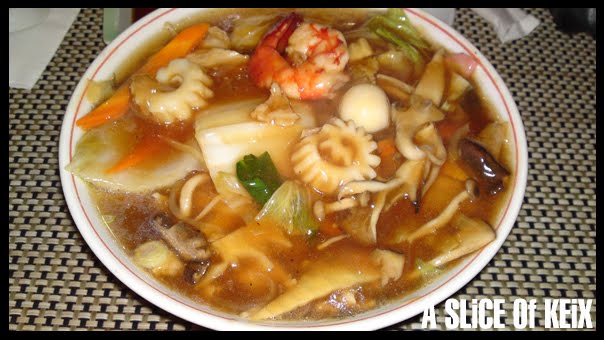Compared to other cuisines, Japanese food is usually more expensive.
Even the not-so-good ones – those Japanese fastfood joints, eat-all-you-can spots and fusion restaurants with their Western-type sushi and over-the-top décor – charge a bit higher than, say, their Chinese or Italian counterparts.
It is, indeed, a sad truth. Here in Metro Manila, you’re always running the risk of spending too much for stinky sashimi, oily tempura or rolls topped with random ingredients.
Here’s one restaurant, however, that has never failed to please.
Nihonbashitei, located at Arnaiz Avenue (formerly Pasay Road), has been my favorite Japanese restaurant for quite some time now.
The place screams Japanese without trying too hard – it’s no surprise that most of its patrons are non-English speaking Japanese men who order a tray of assorted sushi with beer, or a bowl of piping hot ramen (Chinese-style wheat noodles in meat- or fish-based broth).
The prices are quite reasonable, too, considering the quality of the food being served.
Be warned, though – Nihonbashitei is usually packed, especially at night and during weekends, so you may end up standing at the entrance of the restaurant for minutes to get a table.
So if you’re planning to eat there, make a reservation first.
THE PLACE
Nihonbashitei is divided into 2 areas – the first floor, which serves traditional Japanese fare; and the second floor, which is the teppanyaki (dishes cooked in an iron plate) room, though I haven’t tried that one yet.
The first floor’s interiors are fairly simple – brown cushion seats at the bar, plain wooden chairs and tables in the middle, and private rooms separated from the rest of the place by sliding doors and glass windows.
There’s also a common room where customers are required to remove their footwear – here, you are welcomed by low tables and round cushions on the floor.
At the other end of Nihonbashitei’s first floor are clean and well-kept restrooms, a sign of a good restaurant.
As Anthony Bourdain would say, if people running a restaurant can’t keep it clean, you can imagine what their kitchen, hidden away, looks like.
THE MENU
Just looking at the menu will give you an idea of what kind of food to expect in Nihonbashitei.
Japanese characters are written before English translations, which may mean that the restaurant gives more priority to its Japanese patrons over its foreign counterparts.
There are a few pictures, but no descriptions for any dish on the menu can be seen – it’s as if the owners of the restaurant think you already know what you want to order.
But of course, that’s not always the case since Nihonbashitei offers a lot – the restaurant has sushi, sashimi, tempura, yakimono (grilled meat, seafood or vegetables), onigiri (rice ball), kushiyaki (grilled non-poultry dishes), nabe (hot pot dishes), teppanyaki, noodles, salad, curry rice, fried items, and even Chinese food, among others.
Also available are shochu (Japanese distilled spirits which are similar to vodka) and other alcoholic beverages.
The best deals can be found during lunchtime, when Nihonbashitei offers set meals (which include a P200+ main dish, a bowl of rice, and a choice between iced coffee and nata de coco) for as low as P250 each.
If you’re at a loss on what food to get, you can always ask one of the restaurant’s friendly servers to assist you.
THE FOOD
Raw goodies
One of the restaurant’s bestsellers (and a personal favorite) is the toro spicy maki, which contains toro (fatty tuna belly), rice, dried seaweed, sesame seeds, crunchy tempura flakes, and yes, you guessed it – more fatty tuna belly.
For only P165, you get 6 rolls of pure bliss – it’s the perfect balance of flavor, spice and crunch.
The toppings are as tall as the rolls, and are more than enough to make another order of maki.
Nihonbashitei is also popular for its sushi, which are sold per piece. I sampled the tobiko (flying fish roe) sushi since it’s usually not available in other Japanese restaurants (and it’s Utada Hikaru’s favorite!).
The red-orange roe tastes fresh and delicate, but for P55 apiece, I find it a bit expensive. I’d rather have another round of toro spicy maki.
Another great item on the menu is raw uni (sea urchin), which is said to be one of the best in town.
It’s light, sweet, smooth and slightly briny — far from what is usually served at most sushi spots.
Hot dishes
Most Japanese restaurants charge at least P300 for ebi (shrimp) tempura, but here, you get 3 pieces of deep-fried goodness for only P230.
The batter is light and crispy, just right for the slightly sweet shrimp inside.
The ankake ramen, meanwhile, is a delicious and filling treat that’s perfect for the cold and rainy season.
Topped on the noodles and the thick, sweet and savory soup are a variety of toppings – shrimp, cuttlefish, mushrooms, cabbage, carrots, quail eggs, fish cakes and pork slices.
A huge bowl of ankake ramen, which is good for 2 to 3 hungry persons, only costs P250.
Other popular choices for hot dishes include the gyoza (Japanese potstickers) and the chicken teriyaki (grilled chicken in sweet soy sauce).
THE VERDICT
This restaurant, in my opinion, is one of the very few places that offer authentic, unpretentious Japanese fare at very affordable prices – even lower than what is offered by most casual dining joints.
The only downside is the restaurant’s lack of dessert offerings – it only has fresh fruits and ice cream.
But what the heck, I’ll pick this place any day over some cheap but lousy Japanese restaurant.
NIHONBASHITEI
800-A Arnaiz Avenue (formerly Pasay Road)
Makati City
Philippines
For reservations, call (632) 818-8893 or 818-8894








